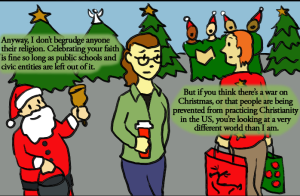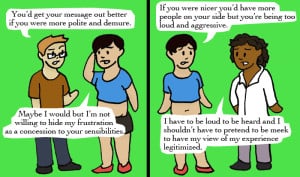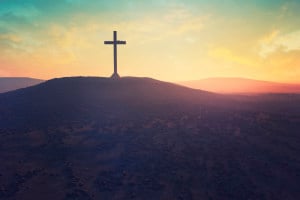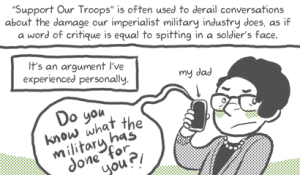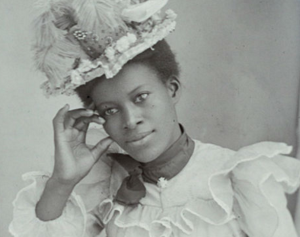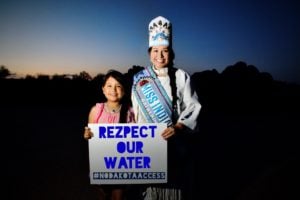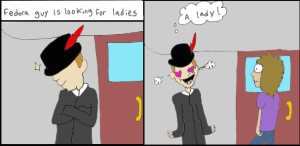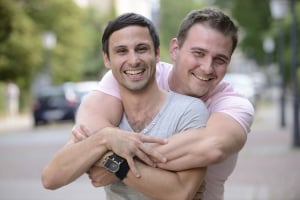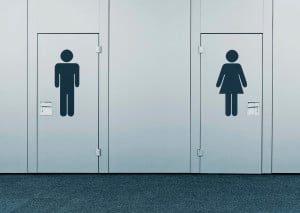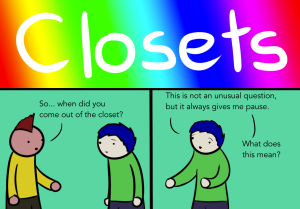
Source: African Sweetheart
Progressive. Liberal. Human rights. Social justice. There are many words used to describe one’s drive to better the world. However, many of these political identities are missing some other words that are vital to political discourse if change is truly the goal.
In order to get the Left in order, I have compiled a list of a few key phrases to keep in mind when reflecting back onto your own politics.
So, buckle up for the guide of your life and see if your politics are radical enough to make real change.
1. Intersectionality
I’m starting off with this particular keyword because I believe it’s the most important part of true radical politics.
The term intersectionality was first coined by Kimberlé Crenshaw in 1989 in her piece “Demarginalizing the Intersection of Race and Sex: A Black Feminist Critique of Antidiscrimination Doctrine, Feminist Theory and Antiracist Politics.”
And because I could not possibly phrase it better than Crenshaw herself, I will let her words explain this groundbreaking term for you here:
“Discrimination, like traffic through an intersection, may flow in one direction, and it may flow in another. If an accident happens in an intersection, it can be caused by cars traveling from any number of directions and, sometimes, from all of them. Similarly, if a Black woman is harmed because she is in an intersection, her injury could result from sex discrimination or race discrimination. […] But it is not always easy to reconstruct an accident: Sometimes the skid marks and the injuries simply indicate that they occurred simultaneously…”
In short, the concept of intersectionality looks to recognize the ways in which multiple marginalized identities interact with one another.
In Crenshaw’s example, this is understood as the intersection of blackness and womanhood in a racist and sexist society. In feminist circles, this intersection is imperative to good politics, since black women and other women of color experience sexism in entirely different ways from white women.
This concept of intersectionality has now been extended to other intersecting identities – like class and sexual orientation – in an effort to understand the ways in which different people experience different forms of oppression.
These ideas are key to making real change since each marginalized identity comes along with different issues that need to be addressed by the community.
For example, Gay Marriage™ rhetoric does not consider intersectionality. How can you tell? You can tell by which issues are prioritized.
Gay Marriage™ is an issue that may be central to cis, white, able-bodied, dyadic (non-intersex), gay folks because they do not have other marginalized identities that cause them to experience more life threatening forms of oppression.
An intersectional queer platform, on the other hand, would take into consideration other ways in which queer people are disproportionately harmed, such as limited access to health care, housing, or employment.
These issues are not touched upon by many mainstream (read: non-intersectional) platforms because they largely affect queer folks who have intersecting marginalized identities.
Big groups like the HRC don’t bring these issues into consideration because they work as big lobby groups. Organizations that focus on lobbying tend to not hold intersectional politics because their main goal is to raise money to lobby with, and the best way to do that is to pander to the groups of people with the most money.
There isn’t a lot of profit in helping those who need it the most.
But if you are truly driven to making real change in your community, you must take into consideration the ways in which other folks in that community may experience oppression based on their own individual intersecting identities.
The best way to accomplish this is to educate yourself on the beautiful galaxy of identities that make up your community and focus on making the most at-risk your central priority.
When you pull the most marginalized to the center, everyone is protected.
2. Visibility
It’s not enough to preach intersectionality. A group or individual must actually act upon those intersectional politics.
One easy way to find out if a group you are working with is truly intersectional is to take a look at who is made visible within that organization.
Who is put in positions of power? Who is placed on posters, commercials, ad campaigns? Whose voice is heard? Who seems to be speaking for the group itself? Who are events and ads targeted at?
If the answer to all these questions is “usually white, cis, able-bodied men,” then the group you are working with is not centering its most marginalized.
When it comes to the “look” or “face” of a “progressive” or “liberal” organization, it should not resemble the power structure already in place in society (ya know, the one doing the oppressing).
It is also important to make sure that organization aren’t simply using diverse faces (tokenizing identities to make them look more diverse then they really are). Make sure that marginalized folks are being heard as well as seen.
When a group is truly dedicated to making sure that all voices are heard, they make sure that those voices are visible, that those identities are represented in a way that they are not in our current society.
3. Expansion
There are things in this world that need to be expanded — health care coverage, access to education, safety, livable wages. But there are some things that should absolutely not be expanded, especially by groups that claim to want to make the world a better place.
One of these horribly large things that needs to be squashed and not expanded is the Prison Industrial Complex (PIC) – that is, if your organization is pushing for criminalization, it’s contributing to this problem.
Now, this giant corporate beast is a difficult thing to dissect in one small portion of a relatively small article. I’ll try my best to lay out what I think it necessary for this particular conversation, but I highly recommend checking out Against Equality’s “Prisons Will Not Protect You”, Michelle Alexander’s The New Jim Crow, Eric A Stanley and Nat Smith’s Captive Genders and Disability Incarcerated (just to name a few).
Many folks’ immediate response to an attack on the prison system is visceral. They quickly imagine a world of chaos and violence, where “criminals” run free (although it’s clear by our history of police violence that not only do criminals run free, but the most violent and racist of those criminals are given guns and badges).
When thinking about the PIC, it is imperative to know the facts of incarceration.
Here are some statistics on the racial implications of the PIC from the NAACP:
- Together, Black and Latinx folks comprised 58% of all prisoners in 2008, even though they make up approximately one quarter of the US population
- According to Unlocking America, if Black and Latinx people were incarcerated at the same rates of white people, today’s prison and jail populations would decline by approximately 50%
- Five times as many white people are using drugs as Black people, yet the latter are sent to prison for drug offenses at ten times the rate of the former
- Black people represent 12% of the total population of drug users, but 38% of those are arrested for drug offenses, and 59% of those are in state prison for a drug offense
- According to the Sentencing Project, Black folks serve virtually as much time in prison for a drug offense (58.7 months) as whites people do for a violent offense (61.7 months)
This is also, within the context of the PIC, a movement towards privatization, where private prisons have quotas of 90% occupancy, driving up the amounts of arrests within a culture of racist, classist arresting.
So, when “progressive” groups push for legislation that will result with more arrests (like Hate Crime Legislation), it’s important to remember that that legislation does not exist in a vacuum.
Don’t fight for one group at the expense of another, and know that anything that puts more bodies in prison is being done at the expense of poor, queer, disabled, black, and brown folk all across the country.
This idea of limited expansion applies to police as well.
The history of the police force is built upon racist violence. It is also important to note that many radical movements, especially queer liberation and black civil rights, were started in response to police brutality.
Pride? It is in “celebration” of anti-police riots.
So, not only should an organization make sure they’re not being complicit in the expansion of the PIC, but it should also make sure that events are made safe for black and brown community members by making sure there is not a heavy police presence.
This is especially true for queer communities, considering the extremely high amounts of violence and neglect shown by the police towards black and Latina trans women.
Keeping your community safe should always take priority over catering to the comfort of those more privileged.
4. Accessibility
For my last key term, I’m bringing up accessibility.
This is oftentimes overlooked by organizations that don’t keep intersectional politics because they already aren’t thinking about the needs of people with different intersecting identities.
Things to think about when wondering if events and groups are accessible: Is this event space/meeting space wheelchair accessible? Is there a large police presence? Is this event in an area hard to reach by walking or public transportation? Is this space in an area that may be dangerous for people of color, gender non-conforming folk, visibly disabled folk?
Does this event require a high entry fee, expensive food or drink, high cost of transportation? Is this event/meeting in a place with a violent history? (I’m looking at you, Ani DiFranco!)Is this article/pamphlet/info sheet so weighed down in political/academic jargon that you need a college degree to understand it? Is this event or meeting at a time when many working class people are at work?
Making sure that events and meetings are accessible and safe(r) for as many people as possible is not only necessary for making real change, but it also makes it much easier for marginalized voices to be heard and represented within activist circles.
Why wouldn’t you want to make sure that as many awesome folks as possible could attend your meetings and events?
***
This list is certainly not a complete one, and I am sure it is not without fault.
But what I do know is that it is the beginning of a conversation that is vital to the success of true progress and change.
What types of qualifications would you add to this list? How do you determine whether an individual, organization, or event is practicing true radical politics?
[do_widget id=”text-101″]
Kris Nelson (they/them) is a queer trans witch with a BA in Gender, Sexuality, and Women’s Studies. They are currently on their way to LA to continue their life of patchmaking, spellcrafting, radical organizing, and spoken word. Kris runs a blog full of short queer-centric radical prose, which can be found at thequeertimes.tumblr.com and a poetry blog that can be found at songswithoutlyrics.tumblr.com. They can be contacted at [email protected] and trans-witch.tumblr.com.
Search our 3000+ articles!
Read our articles about:
Our online racial justice training
Used by hundreds of universities, non-profits, and businesses.
Click to learn more






